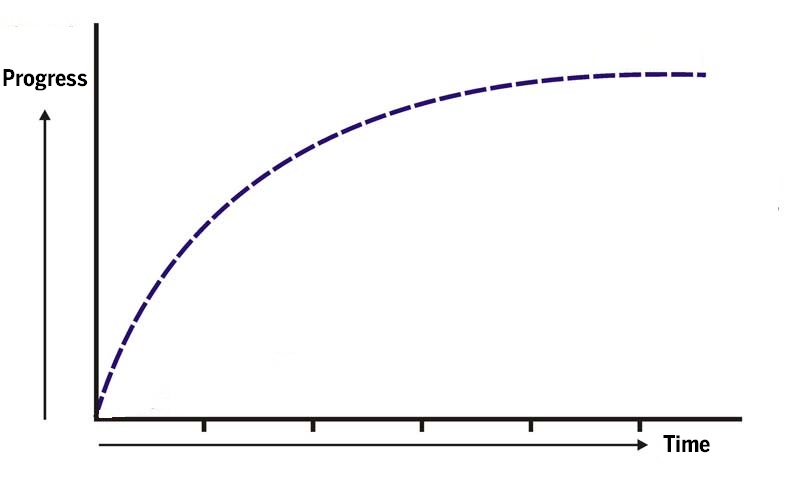Long Term Progress
by Erik Castiglione
When you first start your CrossFit journey, you’re likely to see tremendous gains each time we test a lift. Twenty pounds, fifty, it’s not uncommon. Why is this? For most people, our lifts are new movements. As you familiarize yourself with these movements, you can lift more weight without building more muscle. You may recall from “What We Train: Part 3” that we grow stronger in 4 ways: improving motor patterns, increasing inter muscular coordination, improving intramuscular coordination, and building muscle. The first 3 are neurological, and are developed by repeatedly practicing a movement. Hence your newbie gains.
As you continue training, these jumps become smaller, and sometimes, rarer. This can be demoralizing. I’m here to tell you that it’s a natural progression, as shown below. The good news is that we can continue making progress by being SMART with our training.
How do we do this? First, by focusing on QUALITY over quantity. We heavily regulate our volume and intensity in our program, so this is pretty simple to do. Treat every rep of every set like it’s a PR attempt, and you’ll muster the best technique you can. Technique and movement quality are truly important, so whether it’s a warm-up or an actual max attempt, your technique should be the same. Put in the work, follow the intent of the workout each day, and you’ll make progress.
Second, we can change our mindset to be comfortable with small improvements. We’re going to be testing our lifts soon, and I guarantee I will watch someone hit a 1 lb PR, only to have them dismiss it saying “it’s only one pound.” I’m a huge fan of the 1 lb PR, especially on upper body lifts, and on days when athletes “aren’t really feeling it.” Small gains add up long term, and are more realistic the longer you train. This is true even at elite levels of sport – most world record lifts are broken by 1-2 kgs at a time (when Eddie Hall first deadlift 500kg, he broke the world record by 35 kg, or 77 lbs. THAT is what made the lift all the more impressive.).
By focusing on small gains, you are more likely to make your lifts. Trying to jump too much on PR attempts leads to missed lifts. Even if you lower the weight, you’re fatigued from the missed lift, and less likely to make your subsequent attempt. If you continuously miss lifts, you train yourself to miss lifts, and it becomes self-perpetuating. Instead, focus on a small PR: 1 lb, 5 lbs, 10 lbs, whatever. If it feels light, go heavier. If it’s challenging, call it a day even if you have more in the tank and end on a high note.
By increasing your maxes, correspondingly, your percentages increase. Since most of our training is percentage based, this means that your work sets in turn will become heavier. This will allow you to keep making your lifts even as the weight increases.
Lastly, we can train smarter by focusing on recovery, rather than more training. When your gains start to slow down over time, it can be tempting to think that you need MORE training to keep progressing. The opposite is actually true, especially when you’re lifting heavier weights. The heavier you can lift, the longer it takes your body to recover. So, as we mentioned in the first point, put in the work that day, and make it high quality. That goes for both strength AND conditioning – as we described last week, our conditioning is designed to complement the strength work we do that day. That’s it inside the gym. Outside the gym, make sure you’re sleeping enough, hydrating well, and limiting stress as much as you can. If you’ve got a nagging pain, add in some mobility work, and take care of it.
To conclude, when you’ve been training a while, your progress will slow down. BUT, it does not have to stop. Show up, put in the work, focus on and celebrate small gains, and make sure you recover properly. This will ensure your continued long-term progress.

